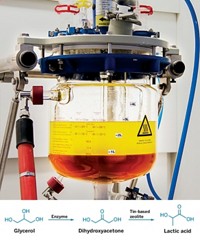Advertisement
Grab your lab coat. Let's get started
Welcome!
Welcome!
Create an account below to get 6 C&EN articles per month, receive newsletters and more - all free.
It seems this is your first time logging in online. Please enter the following information to continue.
As an ACS member you automatically get access to this site. All we need is few more details to create your reading experience.
Not you? Sign in with a different account.
Not you? Sign in with a different account.
ERROR 1
ERROR 1
ERROR 2
ERROR 2
ERROR 2
ERROR 2
ERROR 2
Password and Confirm password must match.
If you have an ACS member number, please enter it here so we can link this account to your membership. (optional)
ERROR 2
ACS values your privacy. By submitting your information, you are gaining access to C&EN and subscribing to our weekly newsletter. We use the information you provide to make your reading experience better, and we will never sell your data to third party members.
Policy
ACS Award For Affordable Green Chemistry
by Alex Scott
February 23, 2015
| A version of this story appeared in
Volume 93, Issue 8
Sponsored by Dow Chemical and endowed by Rohm and Haas
Replacing a major petrochemical process with a bioprocess that provides significant cost and greenhouse gas emissions savings is a career aspiration for many industrial chemists. It’s an aspiration that John Frye and Alan Zacher, chemists with Pacific Northwest National Laboratory (PNNL), along with Todd Werpy, senior vice president of R&D at Archer Daniels Midland (ADM), have succeeded in turning into reality.
Together, the trio of chemists devised an economically viable catalytic process to convert renewable raw materials, including sorbitol, and the biodiesel by-product glycerine into propylene glycol (PG), an intermediate for making polymers, detergents, and more. It is this process that has earned them their ACS award.
Frye’s role in the project was largely to undertake catalyst optimization, development, and testing. Zacher, who is also a chemical engineer, was involved in process engineering, catalyst optimization, and process development. Werpy was the visionary and project lead who kept the science and economic cases yoked together and headed in the right direction.
“The technical challenge was to achieve high yields of PG” from the process, Werpy says. One of the difficulties the team faced was that there was a relatively lower level of understanding about catalysts used in bioprocesses compared with those for petrochemical processes. The team also had to work to overcome the capital and operating costs associated with renewable raw materials. Separately, there were also challenges relating to the purification of the product, Werpy says.
The trio of chemists knew from the get-go that the key to the project’s success would be their ability to develop the right catalyst. They used high-throughput techniques to screen numerous combinations of metals. They settled on a rhenium-based catalyst. The eureka moment for the project came when testing one of the catalysts: “We first observed PG yields from glycerol hydrogenolysis in the 80–90% range,” Frye says. “This kind of selectivity on an early attempt really grabs your attention,” adds Frye, who during his career has been named as an inventor on more than 50 patents.
The researchers have since secured significant patent coverage for the discovery of the rhenium-based catalyst and development of an industrial PG process. In March 2011, ADM opened a PG plant in Decatur, Ill., based on the technology. It has a capacity of 100,000 tons per year, enough to meet 20% of U.S. demand. The facility continues to be the world’s only source of high-purity PG from renewable materials.
The commercial bio-PG process reduces greenhouse gas emissions by 61% when compared with PG derived from petrochemicals. With more than 2 billion lb of petroleum consumed every year in the production of PG, the potential environmental gains from the bioprocess are huge.
The discovery team consisted of several additional chemists working on catalyst development, analytical chemistry, and process development. The team spent several years enhancing the catalysts that led to the more than 90% yields of PG, Werpy says. Developing the commercial project required dozens of chemists, chemical engineers, civil engineers, and a variety of other experts.
The Department of Energy funded the research at PNNL, which is a DOE research lab operated by Battelle Memorial Institute. Battelle licenses the technology to ADM. Both ADM and PNNL were engaged at the R&D stage. ADM has patents relating to the broader industrial process, including product purification.
Each of the trio of chemists who led the project rates it as one of his career highlights. “It isn’t often that you get to be part of the team that was responsible for a discovery and then get to participate in the commercial deployment of that technology,” says Werpy, who is 52.
For Zacher, 45, the project has had the biggest impact on his career of all the research projects he has been involved in so far. “This is partly because it was a syzygy of inspiration, opportunity, and market forces,” he says. “We’ve had cleverer ‘eureka’ ideas, but none of them have had the market—or economic—potential of glycerol to PG,” he says.
Frye, 63, and Zacher continue to work together on a range of projects, including processes for converting biomass into liquid transportation fuels. Lessons learned from the PG project have already made their way into their ongoing research activities. “John is a master at taking a mixture of partially related findings from old projects, remembering unfollowed rabbit trails from prior ideas, and adding a few half-forgotten journal articles to cook up inspiration that totally transforms our approach,” Zacher says.
Generally, however, the level of understanding about bioprocesses remains a long way behind that of chemistry associated with petrochemical feedstocks, Werpy says. If this issue is to be addressed, “we need to do more to educate students on the chemistry of carbohydrates, oils, and proteins,” he says. Additional measures may be required. “We really have an opportunity to improve the cost structure of renewable materials, but it is going to take investment and technology advances in areas like biotechnology, aqueous-phase catalysis, and what I would call nontraditional separations,” Werpy adds.
The researchers will present their award address before the Division of Cellulose & Renewable Materials.








Join the conversation
Contact the reporter
Submit a Letter to the Editor for publication
Engage with us on Twitter